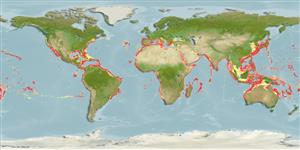Environment: milieu / climate zone / depth range / distribution range
Ecologie
marien; brak water bathydemersaal; diepte 50 - 1000 m (Ref. 6688). Deep-water; 5°C - 13°C; 45°N - 29°S, 180°W - 180°E
Circumglobal in temperate and tropical regions. Eastern Atlantic: Spain to at least 19°S, including the Mediterranean, Canary Islands and Cape Verde. Western Atlantic: southern New England, USA and northern Gulf of Mexico to northern South America (Ref. 7251). Northwest Atlantic: Canada (Ref. 5951).
Grootte / Gewicht / Leeftijd
Maturity: Lm ? range ? - ? cm
Max length : 40.0 cm TL mannelijk / geslacht onbekend; (Ref. 36731); common length : 20.0 cm SL mannelijk / geslacht onbekend; (Ref. 2683)
Dorsale stekels (totaal): 0; Dorsale zachte stralen (totaal): 10-11; Anale stekels 0; Anale zachte stralen: 8 - 10. Body slightly compressed. The head is small; eyes large, diameter greater than snout length. Color is yellow-fawn, with irregular oblique brown blotches on the sides. The operculum is silver-black; anus and gill cavity black; belly stippled black; caudal fin base and inner ventral fin rays black.
Found on the continental shelf and upper slope over mud and clay bottom. Catch data indicate a schooling habit. Feeds mainly on bottom-living invertebrates. Also known to feed on pelagic crustaceans like euphausiids, decapods and mysids (Ref. 27637). A hermaphroditic species. Marketed fresh and sometimes made into fishmeal (Ref. 6688). Young are pelagic, living near the surface, the adults are demersal, living between 50 and 1000 m depth (Ref. 47377).
Levenscyclus en paargedrag
Maturiteit | Voortplanting | Paaien | Eieren | Fecunditeit | Larven
Merrett, N.R., 1990. Chlorophthalmidae. p. 351-360. In J.C. Quero, J.C. Hureau, C. Karrer, A. Post and L. Saldanha (eds.) Check-list of the fishes of the eastern tropical Atlantic (CLOFETA). JNICT, Lisbon; SEI, Paris; and UNESCO, Paris. Vol. 1. (Ref. 3590)
Status op de Rode Lijst van het IUCN (Ref. 130435)
Gevaar voor de mens
Harmless
Gebruik door de mens
Visserij: van minder commercieel belang
Tools
Speciale rapporten
Download XML
Internetbronnen
Estimates based on models
Preferred temperature (Ref.
123201): 6.4 - 19.2, mean 12.7 °C (based on 1136 cells).
Fylogenetische diversiteitsindex (Ref.
82804): PD
50 = 0.5000 [Uniqueness, from 0.5 = low to 2.0 = high].
Bayesian length-weight: a=0.00417 (0.00313 - 0.00555), b=3.15 (3.06 - 3.24), in cm total length, based on LWR estimates for this species (Ref.
93245).
Trofisch niveau (Ref.
69278): 3.7 ±0.0 se; based on diet studies.
Generation time: 4.6 ( na - na) years. Estimated as median ln(3)/K based on 1
growth studies.
Weerstandsvermogen (Ref.
120179): Gemiddeld, minimale populatieverdubbelingstijd 1,4-4,4 jaar (Assuming tm=3-4).
Fishing Vulnerability (Ref.
59153): Moderate vulnerability (40 of 100).
Nutrients (Ref.
124155): Calcium = 24.1 [9.7, 65.8] mg/100g; Iron = 0.373 [0.127, 0.790] mg/100g; Protein = 15.2 [12.2, 17.6] %; Omega3 = 0.213 [0.066, 0.535] g/100g; Selenium = 19.3 [6.0, 45.3] μg/100g; VitaminA = 10.2 [1.8, 53.4] μg/100g; Zinc = 0.481 [0.300, 0.738] mg/100g (wet weight); based on
nutrient studies.
